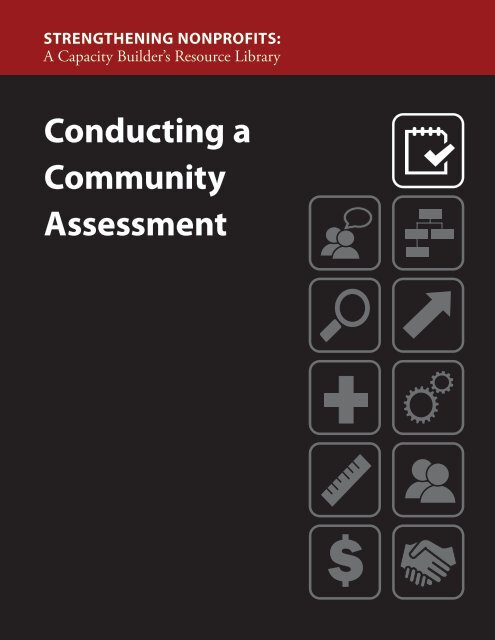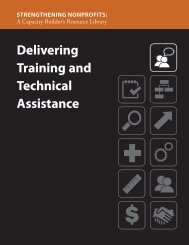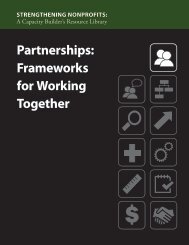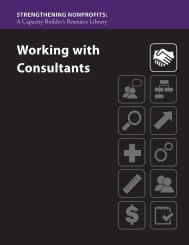Conducting a Community Assessment - Strengthening Nonprofits
Conducting a Community Assessment - Strengthening Nonprofits
Conducting a Community Assessment - Strengthening Nonprofits
Create successful ePaper yourself
Turn your PDF publications into a flip-book with our unique Google optimized e-Paper software.
Step 2: Decide to Go Solo or CollaborateDeciding the scope will highlight the choices available to you for conducting your community assessment.You can decide to “go solo” and carry the entire responsibility for completing all of the communityassessment activities; or, you can work with community partners as a collaborative project to complete theassessment. Potential community partners include corporations, nonprofit organizations, local communityorganizations, foundations that provide grants to your community, universities, and government entities.One of the most important factors to consider is the level of resources you have to conduct a communityassessment. Examine the time, effort, and human resources that are available from your various stakeholders,including staff, volunteers, consultants, and board members. Establishing collaborations will increase theresources available to conduct a quality and useful assessment.Benefits of Collaboration:• Engages more community members in the assessment planning and implementation.• Increases access to more data sources to answer the key questions.• More resources are available to conduct the assessment and cover expenses.• Establishes relationships that will be important for leading actions identified in the communityassessment findings.If you decide to work collaboratively with partners to complete a community needs assessment, considerusing a memorandum of understanding (MOU) between the involved parties to ensure that eachorganization fully understands and commits to the efforts involved. An MOU outlines key responsibilities ofthe involved organizations. See Appendix A for a sample MOU.Step 3: Collect DataThis step will guide you through finding credible sources of information and, when necessary, developingyour own data collection tools. In any data collection effort, it is essential that you first set limits on howmuch data you will collect and analyze. Consider the amount of time and resources you have available priorto selecting any specific method or combination of methods. Prioritize your data collection needs accordingto what is essential to complete your community assessment. Document your data collection efforts using the“Creating a Data Collection Plan Worksheet” (Appendix B). In using this tool, you will list the key questionsthat you identified in Step 1 and then identify probable sources of information.Your community assessment will be based on two types of data sources: secondary and primary. Start yourdata collection with secondary sources—data that has already been collected by others. Other members ofyour community may have the information that you seek. Begin with local sources of information and thenbroaden your search as necessary. Focus on quality of data as opposed to quantity, so you can dedicate moretime to other aspects of the community assessment. For a table of potential secondary sources, see “LocatingSecondary Sources of Information” (Appendix C).Primary data is data collected by the person or group conducting the assessment. Primary source datacollection methods should be used to address questions that cannot be answered by secondary sources or togain a better understanding of a particular issue. There are several methods for collecting primary sources ofdata for your community assessment, including questionnaires, observation, focus groups, interviews, andcase studies. For a description of these methods, including the advantages, disadvantages, resources, andamount of time required for each one, refer to the online tools listed on the following page.7
Your timeline should reflect the level of detail you want in your community assessment. A communityassessment can be a “snapshot” of a community need based on local secondary sources and few primarysources; or it can be comprehensive, based on an extensive review of secondary sources and many sources ofprimary data. Clarify who will be responsible for carrying out different parts of the data collection plan. Setdata collection deadlines and stick to them. It is easy to spend too much time in the data collection phase.Online Tools for Further ReadingSuzanne Bouffard and Priscilla M. D. Little, “Detangling Data Collection: Methods for Gathering Data,”Out-of-School Time Evaluation Snapshot no. 5 (August 2004), Harvard Family Research Project, HarvardGraduate School of Education.Nobuko Mizoguchi, Mia Luluquisen, Sandra Witt, and Liz Maker, “Choosing Your Data CollectionMethods,” in A Handbook for Participatory <strong>Community</strong> <strong>Assessment</strong>s: Experiences from Alameda County(Oakland, CA: Alameda County Public Health Department, 2004), 33-39.Tips for Steps 1–3• Take time to set a clearly defined scope.• Develop a work plan to assign roles, responsibilities, and time frames for major activities involved inconducting the assessment.• Prioritize your needs by collecting data that addresses your key questions.• You may not be able to answer all of your key questions. Focus on what is essential to know versus what isgood to know.• If you decide to create a data collection instrument, understand your resources and do what is manageable.Step 4: Determine Key FindingsThe data collection step will result in a lot of data and information about your community needs and assets.You can analyze the data to identify the assessment’s key findings. Key findings serve several purposes:• They validate anecdotal evidence of community needs and assets.• They highlight significant trends found in the data collection process.• They reveal differences across segments of the community.• They help clarify answers to the community assessment’s key questions.The key findings can be organized into categories to help summarize the data. When you separate your keyfindings from one another, you can use them more effectively when planning your response. Common keyfindings categories used in community assessments include strengths, gaps, opportunities, and challenges.For examples, see the “Determining Key Findings Worksheet” (Appendix D).8
Step 5: Set Priorities and Create an Action PlanThe completion of a community assessment process should allow you to make informed decisions about yourgoals and objectives. You are able to identify specific needs that came up in your assessment that you want toaddress. Step five of the community assessment process is to set priorities based on your findings and createan action plan to guide your post-assessment planning. For each part of your plan, determine how you willmeasure the effectiveness of your actions. Adopt measures that help define your strategy and that you will beable to track over time.Priority setting is difficult. It requires developing consensus among community members with differentopinions and views on how community issues should be addressed. Cornell University Cooperative Extensionidentifies four barriers to priority setting and offers suggestions for minimizing these barriers: 1 31. The Human Problem — the difficulty of getting people to focus on key issues, decisions, and conflicts• Start by striving for consensus on what you are trying to accomplish by priority setting. Why are wedoing this and what are the stakes?• Actively recognize that there is strength in differing viewpoints and don’t place viewpoints in valueorder.• Build in time to allow people to reflect on information presented, digest it, and modify decisions.2. The Process Problem — the challenge of managing information and ideas during a priority-settingprocess• Be very specific in defining priorities to minimize multiple interpretations.• Make key information available prior to decision meetings.• Beware of taking too much time to analyze information (“analysis paralysis”) and/or rushing to meetdeadlines.3. The Structural Problem — the difficulty of priority setting across different issue areas• Cultivate open communication.• Carefully nurture relationships throughout the planning process.• Keep focus on current priorities, not precedent.4. The Institutional Problem — the challenge of translating priorities into action• Build on existing strengths in implementation.• Ensure that you have a well-defined implementation plan.• Make sure that individuals responsible for carrying out key tasks are committed to implementingchanges.3 Michael W. Duttweiler, Priority Setting Resources: Selected Background Information and Techniques (Ithaca, NY: CornellUniversity Cooperative Extension, 2008), 3-5. Available online at http://staff.cce.cornell.edu/administration/program/documents/priority_setting_tools.pdf9
An action plan template is provided in Appendix E. Your action plan should be based on the priorities setduring this phase and include specific actions and deadlines, as well as identify a person responsible for eachaction. The action plan is an excellent tool to use in setting agendas for future meetings.Step 6: Share Your FindingsThe last step of your community assessment is to share what you have learned with others and to disseminateyour plan. Now that you have taken the time to find out information about your community, you shouldallow the community to benefit from your findings. <strong>Community</strong> members are more likely to support yourefforts when they have a clear understanding of the work you have done and of what their community needs.You can hold community meetings to share your report with community members or issue press releases toincrease dissemination in different media outlets. In addition to the full report, consider publishing a onepagebrochure to summarize key findings and actions from the community assessment. The full report shouldbe available on your website. If you collaborated with community partners, the report should be available ontheir websites as well.Tips for Steps 4–6• Remember that key findings should point to an asset or need of the population of your community.• Key findings may be related to more than one summary category.• Use information from your community assessment to document your priorities.• Use charts and graphs to illustrate the finding for non-technical people.• Continue to work with community members to identify your implementation team. • Give community members that were not involved in the assessment an opportunity to participate in theimplementation.10
ADDITIONAL RESOURCES<strong>Community</strong> Development - Data Information and Analysis Laboratory (CD-DIAL), Iowa State UniversityExtension, “Preparing for a Collaborative <strong>Community</strong> <strong>Assessment</strong>” (Ames, IA: ISU, 2001),www.extension.iastate.edu/Publications/CRD334.pdf.Rotary International, <strong>Community</strong> <strong>Assessment</strong> Tools: A Companion Piece to Communities in Action — A Guideto Effective Service Projects (Evanston, IL: Rotary International, 2008), www.rotary.org/RIdocuments/en_pdf/605c_en.pdf.Underage Drinking Enforcement Training Center, “<strong>Community</strong>-based Programs: Survey and <strong>Community</strong><strong>Assessment</strong> Tools,” http://www.udetc.org/surveyandcommunity.asp.U.S. Department of Education and the Regional Educational Laboratory Network, “<strong>Conducting</strong> a<strong>Community</strong> <strong>Assessment</strong>,” in Putting the Pieces Together: Comprehensive School-linked Strategies for Childrenand Families (Washington, DC: Department of Education, 1996), http://www.ncrel.org/sdrs/areas/issues/envrnmnt/css/ppt/putting.htm.University of Kansas Work Group for <strong>Community</strong> Health and Development, “<strong>Community</strong> <strong>Assessment</strong>,Agenda Setting, and Choice of Broad Strategies,” in <strong>Community</strong> Tool Box (Lawrence KS: KU Work Groupfor <strong>Community</strong> Health and Development, 2010), http://ctb.ku.edu/en/tablecontents/index.aspx.11
APPENDICESAPPENDIX ASample Memorandum of UnderstandingPartnership AgreementMemorandum of UnderstandingORGANIZATION 1 AND ORGANIZATION 2This Memorandum of Understanding (MOU) describes the responsibilities and expectations between Organization 1 (Org1)and Organization 2 (Org2), for the partnership to complete a community needs assessment for [name of community]. Thepurpose of this assessment is to discover the unique needs of this community as it relates to [at-risk youth, elders in need, othersocial service areas].RESPONSIBILITIES AND EXPECTATIONSFor the assessment, Org1 serves as the “lead” organization. As the lead organization, Org1 is responsible for the following:• [List the specific responsibilities of the lead agency]• [List specific resources being contributed by the lead agency, including: staff time—list names and the amount of time to becontributed; space; materials; or money]Under this Agreement, Org2 agrees to:• [List the specific responsibilities of the assisting agency]• [List specific resources being contributed by the lead agency, including: staff time—list names and the amount of time to becontributed; space; materials; or money]TIME PERIODThe community assessment is expected to be completed within [three months, six month, etc.]TERMINATIONOrg1 may terminate this Agreement, in whole or in part, with or without cause, with a seven (7) day written notice oftermination. Such notice shall be given in writing to Org2 and shall be sent via certified or registered mail with return receiptrequested.Signatures of Authorized RepresentativesOrg 1 Representative [Type name, title]DateOrg 2 Representative [Type name, title]DateAppendix A | 12
APPENDIX BWorksheet: Creating a Data Collection PlanUse this document to plan your data collection efforts. List your key questions and decide whether the data for each question can be found by using a secondary orprimary source. Identify the potential method(s) you will use.Note:• A secondary source provides information you can glean from a website (such as Census.gov) or a conversation (talking with a reporter or professor).• A primary source provides information you produce yourself by creating a survey, holding a focus group, etc.• Secondary sources are listed first because that is where your research will begin.KEY QUESTION SECONDARY? PRIMARY? POTENTIAL METHODExample: What are the basic demographics of my community? (income levels, races/ethnicities, number of youth)Yes No Secondary: Online resourcesExample: What age group in our community is most at risk for becoming involved ingangs?Yes Yes Secondary: Online resources and informal interviewsfor data on gang activity in my communityPrimary: Interviews with former gang-involved youthto add personal testimony to the raw dataCOMMUNITY QUESTIONS
POTENTIAL TOPICS POTENTIAL SOURCES OFINFORMATIONDESCRIPTION OF SOURCEConditions Shapingyour <strong>Community</strong>:Social, political, andeconomic (continued)Local government taskforce/reportsLocal governments often solicit groups to research particular community issues. Contact your county or city government andrequest copies of any relevant reports or materials that could inform your research.Foundation reports Local foundations often conduct research on community issues to inform their grant programs. Contact your local communityfoundation or other private and family foundations in your area and inquire about any research they may have done on issuesrelated to your nonprofit. To locate foundations in your area, visit the Foundation Center.Crime:Violent offenses, drugoffenses, drug useBureau of Justice Statistics(BJS)For a broad look at crime, the BJS provides a wealth of data on both national, state, and city trends. It also allows you to createyour own breakouts (providing data on race, age, type of crime, and so on) for your local area or state.Resources/Assetsfor <strong>Nonprofits</strong>:Funding, technicalassistance, volunteersMembership associationsFor nonprofitsMany states have membership organizations for nonprofits that provide training and technical assistance to organizations thatmay or may not be a member. These associations often conduct research on nonprofits in the state as well. Visit the NationalCouncil of Nonprofit Associations to find out if there is a membership organization for nonprofits in your state.Foundation Center The Foundation Center is the nation’s leading authority on philanthropy. The Center maintains a comprehensive database onU.S. grantmakers and their grants. Visit the Foundation Center website to search for foundations serving your local area.Alliance for NonprofitManagement (ANM)ANM has a searchable database for local consultants and trainers that may be providing services to nonprofits in your targetarea.Note that published data change regularly; check publication dates and ask for updates if necessary.
APPENDIX DWorksheet: Determining Key FindingsThis document provides examples of key findings. You can empty and copy this table to help document your discussion of key findings from your communityassessment.KEY FINDINGS STRENGTHS GAPS OPPORTUNITIES CHALLENGES1. There are not enough collaborative efforts among organizations servingthe homeless. Previous efforts were non-sustainable.X2. <strong>Community</strong> youth programs have a difficult time retaining youth in theirprograms.X3. People are aware of services and positive development opportunities inthe community.X4. The elderly are disinterested in current programs and services. X
APPENDIX EAction Plan TemplateThis document provides a template for planning a response to the findings in your community assessment.KEY FINDING ACTIVITY OR RESPONSE DEADLINE PERSON RESPONSIBLE INDICATORS OF SUCCESSLack of collaborationConvene monthly serviceprovider meetingsFirst Tuesday of each monthRotating hosts among signersof MOUPercent of MOU signersattending each meetingLack of collaborationApply for funding to establisha shared referral networkFall 2011 XYZ, ABC OrganizationsAward of grant to establishreferral systems policies andprocedures
This work was created by the Compassion Capital Fund National Resource Center, operated byDare Mighty Things, Inc., in the performance of Health and Human Services Contract NumberHHSP23320082912YC.






